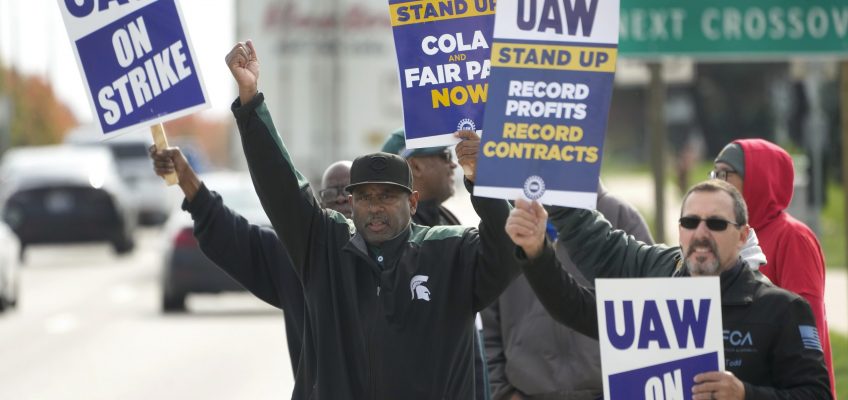A tentative agreement announced Wednesday between union autoworkers and Ford was welcome news to the White House and could be a sign that at least one of the problems on President Joe Biden’s plate could be nearing resolution.
Several hurdles remain to a settlement of the United Auto Workers’ strike against the Big Three, including whether workers at Ford would ratify an agreement and, if so, whether its terms can be extended to General Motors and Stellantis. The transition to electric vehicles has also been a major sticking point, with the UAW fearing a loss of jobs to non-union plants.
But it is the first major breakthrough in a strike that appeared to be digging in for the long haul.
A wider deal would come as a relief to the White House and Democrats representing car-producing regions, who had supported the workers’ demands even though some feared that an extended strike could harm the economy, sour public sentiment and hamstring their electoral prospects in 2024.
The White House was quick to applaud the development.
“This tentative agreement is a testament to the power of employers and employees coming together to work out their differences at the bargaining table in a manner that helps businesses succeed while helping workers secure pay and benefits they can raise a family on and retire with dignity and respect,” Biden said in a statement.
If the deal sticks, and similar agreements are struck with the other companies, it would be one of the organized labor’s biggest victories in a year of worker unrest across the country.
“We won things nobody thought possible,” UAW President Shawn Fain said in a statement. “Since the strike began, Ford put 50% more on the table than when we walked out. This agreement sets us on a new path to make things right at Ford, at the Big Three, and across the auto industry. Together, we are turning the tide for the working class in this country.”
The agreement announced Wednesday includes a 25 percent wage increase for workers across the course of the four-year contract. The union had initially demanded a 40 percent increase, while the companies’ initial offers were in the single digits.
The tentative agreement also significantly boosts the starting pay for new employees and accelerates the rate at which they escalate to the highest wage tier, shaving off several years from the previous schedule. It also reinstates a cost-of-living adjustment that was done away with more than a decade ago amid the American auto industry’s financial struggles.
UAW also said it won the ability to strike in the event of future plant closures.
Fain has been expanding the strike on a piecemeal basis since the strike began Sept. 15. In total, more than 45,000 workers have walked out of 46 facilities in 22 states.
Workers most recently walked out of GM and Stellantis facilities, as Fain said the companies had fallen behind Ford’s offer.
The tentative agreement will go next to the union’s members for ratification.
The UAW said Ford workers would return to work during the ratification process but the strikes would continue at GM and Stellantis.
Ford has laid off the most workers of the three companies — 3,167 as of Wednesday — citing downstream effects of the strike. Between those employees and the striking workers, nearly 20,000 people have been off the job at Ford plants since the walkouts began.
Ford CEO and President Jim Farley said he was “pleased to have reached a tentative agreement” and “focused on restarting Kentucky Truck Plant, Michigan Assembly Plant and Chicago Assembly Plant, calling 20,000 Ford employees back to work and shipping our full lineup to our customers again.”
GM on Tuesday said the strike has cost it $800 million up to that point. Thousands of workers across the constellation of suppliers affiliated with the Big Three have also been affected by the weekslong strikes.
The electric vehicle transition has loomed over the negotiations, as it represents a turning point for both the industry and the union, which doesn’t have as strong of a foothold in EV facilities as traditional plants.
GM earlier in October agreed to include workers at its battery plants in its master labor agreement with the union, a major win for UAW.


Leave a Reply